Handling Destructive Chewing in Dogs
Posted: 08/15/2022 | BY: Erin Cain | Categories: Behavior , Dog , Pet care
Do you have a dog that likes to chew on everything? If so, you know how difficult it can be to keep them from destroying your belongings. This blog post will discuss some tips for handling destructive chewing in dogs. Following these tips can help your dog redirect their chewing behavior, keep your belongings safe, and lessen the frustration between you and your pup.
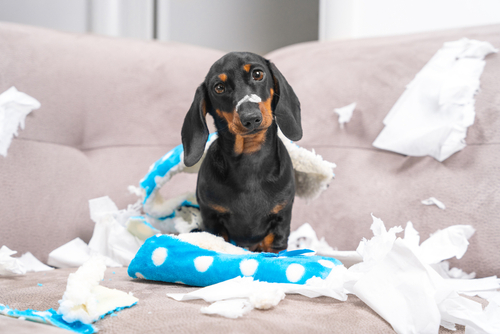
Why do dogs chew so much?
Puppies and some adult dogs have to chew on something, and it’s a no-brainer that they will chew on just about anything you don’t want them to. It may be a minor infraction, or you might end up with a dog that eats you out of the house and home, or at least, that new pair of shoes.
Puppies chew for two reasons. The first phase occurs when a puppy is teething and must have things in his mouth to satisfy his physical urges. This phase should come to a close when all a dog’s adult teeth have emerged, which occurs around five to six months old. The second chewing phase begins at approximately seven to eight months and can last up to two years. During this phase, puppies chew for enjoyment and or due to boredom rather than teething. Therefore, when your puppy chews, he does so because it’s instinctual and a way to explore the world around him.
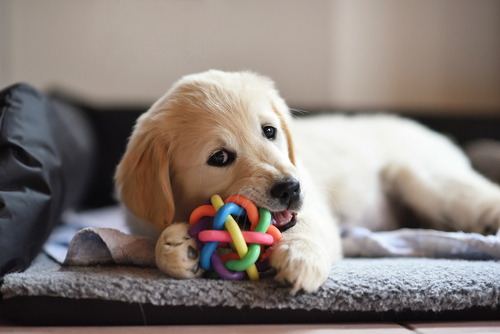
It’s vitally important to keep your adolescent puppy occupied to prevent him from getting into trouble. When a puppy chews for pleasure, he finds the activity rewarding. It’s fun! Dogs have no notion of right or wrong, so your pup may have no idea that you want him to chew on his chew toy rather than your television remote. It’s all the same to him. Your puppy can begin learning to control his chewing as early as possible, so the methods for influencing both forms of chewing are relatively similar.
If you have an adult dog who chews aggressively, especially if he has never done so before, that may be a sign that not all is well with your dog. Many adult dogs engage in destructive chewing in dogs for the following reasons:
- they suffer from separation anxiety
- they are experiencing stress and chew as a coping mechanism
- they don’t have access to appropriate chew toys
- they are fearful
- they were not taught what is and what isn’t acceptable to chew as puppies
For puppies and adult dogs, the reason for chewing may be much simpler: it just feels good. Here are some guidelines for handling chewing issues.
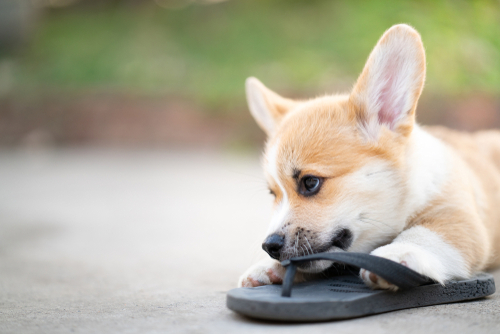
How to handle destructive chewing in dogs
Focus on canine mental and physical fitness.
Every puppy and adult dog has different energy needs, so you must tailor playtime and exercise to your specific pup. As the old adage goes, “A tired puppy is a content puppy.” If you have a bored dog, they’ll find something to keep themselves entertained. Wearing a dog out with the right amount of exercise, dependent on the dog’s age and health, will reduce and destructive chewing on the house.
While daily outdoor play and walks are excellent forms of exercise for your dog, they may not be enough to alleviate his boredom. Take your pup somewhere new and let him exhaust himself by sniffing the territory around him. That will actually tire him out more than a one-mile non-stop walk will.
If your dog enjoys the company of other canines, consider a day or two a week at a local doggy daycare to burn off his high-energy. If your schedule prevents you from being able to exercise your dog, you may want to hire a professional dog sitter or dog walker to keep your dog active and wear him out during the day.
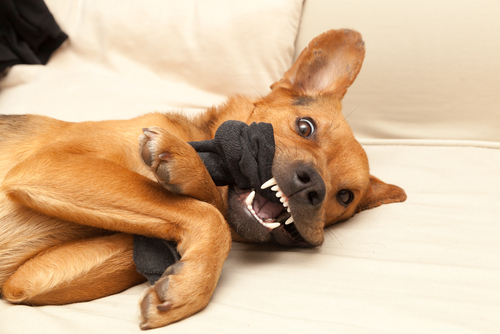
Swap out different chew toys.
Switching out chew toys and rotating them weekly is crucial, so your pup does not become bored with them. Instead of bowls, put their food in a puzzle toy or fill up an old Kong-type toy with kibble. For more advanced chewers, you can cover the openings of puzzle toys with peanut butter. Freeze the toy overnight, and your dog will love the cold treat and the mental stimulation that accompanies it.
You’ll want to keep certain items hidden so they don’t get bored too quickly— novelty is key here. To help your dog chew without damaging furniture or rugs, provide plenty of outlets with various types and sizes. A single toy isn’t enough — make sure you have a bunch on hand. Swap out a brand new toy whenever you see your dog with an off-limits item in his mouth.
Be responsible for your property.
The simple rule is this: if you don’t want your dog to chew something, keep it out of his reach. Destructive dog chewing often happens because tempting items are left where a dog can access them. Responsible pet parents can help cut down on chewing incidents by taking time to ensure that valuable items, like shoes, remote controls, garbage, books, and eyeglasses, are placed where their dog can’t find them.
To steer your dog away from inappropriate chewing targets, give your pup chew toys that are not household items. Be careful not to confuse your dog by giving him socks or shoes as toys. Avoid offering these items as “chew toys,” and then become upset when your dog can’t tell the difference between the shoes you want chewed and the ones you don’t.
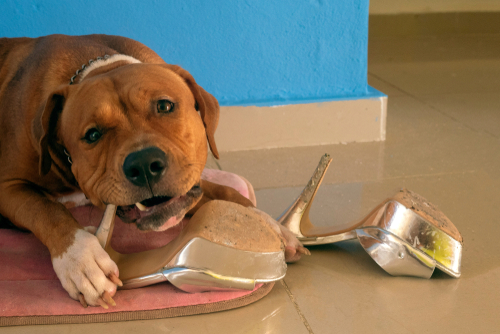
Consider using an unpleasant taste.
Paw-safe bitter sprays can be applied to furniture and cabinets in order deter problem chewers. These chemicals leave an unpleasant taste wherever they’re sprayed, making those surfaces a whole lot less tempting for your pup! Supervise your dog when first using a deterrent, as some can chew even those coated with bitter spray. Be aware that you’ll need to reapply these products for them work effectively and maintain that effectiveness over time.
Keep your dog from wandering around the house.
Be sure not to let your destructive chewer puppy roam the house for hours when you leave. You can look into doggie daycare options or dog daycare alternatives to keep him from making a mess. Once he is more reliable, you can gradually give him more freedom in the house.
If doggy daycare isn’t possible in your area, then crate training is your best bet to keep your dog — and your household items — safe when you aren’t home. A crate can become a den-like place of security for your dog, and it will prevent him from becoming bored, wandering around the house, and getting into mischief.
Not all pet parents have crates for their pups. Instead of a crate, you can create a safe space for your dog to prevent behavior issues, like destructive chewing, that might arise if he has free roam of the house. To create the perfect environment, start with providing just one small area for your dog, such as a small spare bedroom. Then add your dog’s favorite bed and toys, and restrict access through an automatic pet door across the room’s entrance. With space restrictions, you can ensure a reduction in destructive chewing in dogs.
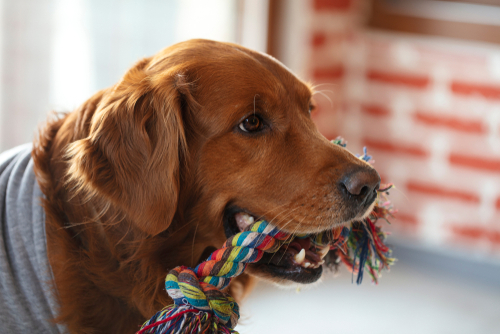
Keep your canine chewer safe with pet insurance.
It’s a natural instinct for dogs to chew, but without careful attention and planning, it’s easy for dogs to chew things they shouldn’t. That’s why it’s so important to address destructive chewing in dogs. Sometimes, despite your best efforts, your dog chews something dangerous. You may have to take your dog to an emergency vet clinic due to a puncture or obstruction caused by the item. In those moments, you’ll want to worry about your dog’s wellbeing, not how you are going to pay for this unexpected expense.
That’s why a pet insurance plan for your dog is the best decision a pet parent can make. Pet Insurance Review will help you find the dog health insurance policy that works for your dog and your budget. Get your dog’s free quote, and protect your best furry friend today.
References:
- Pultarova, T. (2017). Why Do Dogs Chew Everything? Retrieved from https://www.livescience.com/61096-why-dogs-chew-everything.html
- Carolina Veterinary Specialists Matthews. (2022). Problem Behaviors — Dog Chewing. Retrieved from https://www.matthews.carolinavet.com/site/pet-health-blog/2021/03/15/how-to-stop-dog-from-chewing
- Wertkin, S. (2019). The Sniff Walk. Retrieved from https://educanine.org/blog/f/the-sniff-walk
- Bergeland, H. (2021). Dog-Friendly Decor: How to Turn Any Room Into a Safe Space for Your BFF. Retrieved from https://www.dailypaws.com/living-with-pets/pet-friendly-home/dog-room-ideas
- Flowers, A. (2021). Taste Deterrents for Cats and Dogs. Retrieved from https://pets.webmd.com/taste-deterrents
Disclaimer
The information contained on this blog is intended for informational and educational purposes only and should not be construed as medical advice. It is not a substitute for professional veterinary care. Always consult with your veterinarian before making any changes to your pet's health care or treatment plan.
The authors of this blog are not veterinarians and do not claim to be experts in pet health. The information provided here is based on our own experiences and research, as well as information from reputable sources. However, we cannot guarantee the accuracy or completeness of this information.
We encourage you to do your own research and consult with your veterinarian before making any decisions about your pet's health.
Previous post
What is Canine Parvovirus?Next post
8 Common Pet Parent Mistakes to AvoidCompare top pet insurance providers & plans.
Enter your dog’s age in years and months to calculate their age equivalent to human years.
Calculate your dog’s ageEnter your cat’s age in years and months to calculate their age equivalent to human years.
Calculate your cat’s age